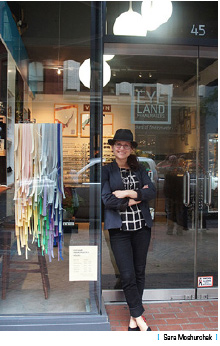
By Paddy Kamen
Whether you’re opening your first store or your umpteenth, there’s plenty to consider, starting with WHO will you be serving, WHERE is best to locate, and HOW will your store speak to your clientele.
The real estate mantra, ‘location, location, location’ is an important one, but like many over-simplifications it belies the complexity of the decisions required to open an optical store. It also ignores the fact that location is not even the first step in the decision-making process. Your store can still fail if location is your only concern.
What comes before location? Who you want to serve, according to the experts. Your ideal customer should be reflected in each essential aspect of your store: location, design and product composition.
“Retailers need to be really clear on who their target market is,” says Margaret Osborne, acting chair of the School of Marketing and Advertising at Toronto’s Seneca College. “People without a marketing background don’t realize how important it is to have an in-depth understanding of their ideal customer. A good marketer will write a story about these customers that might be 30 pages long, looking at their values, attitudes and beliefs in addition to their income and education level. Do they want convenience or intimate service? Are they fascinated by precision goods or do they prefer value above all?”
Customer analysis will contribute to the location decision. “If you understand your customer you will know which location will make or break your business,” says Osborne. “If you’re dealing with clients who value convenience then you should be in a high-traffic location with good parking. If pricing is paramount then you’ll need a location with lower rent. The image has to be consistent as well. If you’re looking to do a boutique offering with higher-quality product, your location will have to be consistent with that as well.”
Intrinsic to Osborne’s argument is that you can’t appeal to everyone and the more you try, the more watered down your value proposition becomes. “If you don’t have a formal background in marketing either seek professional advice or educate yourself online,” she says.
Mani Vaghedi, president of Washington, D.C.-based CNS Frame Displays, agrees with Osborne. Vaghedi advises clients informally on setting up their retail stores and clinics. “The business plan is often the problem. I find that many people don’t narrow down their target market, nor do they plan financially for the six to eight months it takes to get a business on its feet. If they spend too much money in the set up they don’t have enough of a cushion. If they spend too little, their store just doesn’t cut it. An optimized business plan developed with the aid of professionals and a marketing plan for the first few years will go a long way to ensuring success. In my experience the biggest mistake retailers make is under-spending for the practice and not doing enough advertising.”
The type of retailers around your location sets the tone and attracts shoppers. Sometimes it pays to be near those who are your competitors, says Osborne. “You know how you often see gas stations grouped together? Economic game theory says you should locate where you competitors are because that’s where people go to look for eyewear. It’s better to be next door rather than a mile away if your competitors already have traffic, and the smart people go where the action is.”
Anchor stores in the area will be key if your preferred customer is seeking convenience above all. If they can grab a ‘Tim’s’ coffee, pick up their garden supplies at Canadian Tire and drop into a Shopper’s Drug Mart to pick up cosmetics before heading to your shop to choose eyeglass frames or contact lens supplies, they’ll be happy campers, indeed. However, the fashion-oriented customer will be attracted to the eyewear store that is near other fashion retailers.
Michael Kehoe owns and operates Fairfield Commercial Real Estate Inc., a Calgary-based brokerage. He works with commercial property owners and retailers seeking locations across western Canada. “Eyewear is very fashionable so a venue with pro-fashion tenants and jewelers clustered together encourages cross-shopping,” he says. “That way, retailers can enjoy the synergy of the traffic generated by their neighbours.”
Being in ‘the shadow’ of a regional shopping centre that is dominated by chain stores can certainly help, adds Kehoe. “If you can be within four-to-five blocks of a shopping centre on a main road with good signage, you will have achieved more affordable rent than you would in the mall, along with high visibility and consumer traffic.”
Things are changing in retail, with large enclosed malls losing some of their shine for the first time since their inception in the mid-1950s.“Shopping centers are moving toward dining and entertainment centres and offering more services in addition to retail,” says Kehoe. “Some of the older models are being focused outwards (de-malled) and turned into convenience and power centres. The Don Mills Centre in Toronto is an example of this, as is Deer Valley in Calgary, which was de-malled three years ago. This elminates the closed pedestrian mall and focuses the stores outward. The operating costs are lower for the property owners and retailers get more exposure to street traffic. This particularly suits those smaller malls in areas where large regional malls dominate. De-malling is a very successful strategy.”
Strip malls can be an excellent location choice for optical retailers, especially with the synergy of complementary tenants. But optometrist Diana Monea, proprietor of three stores (one in Regina and two in Calgary) once found herself in a problematic situation with one of her strip mall locations. “We had professional, health-related neighbours when we moved in, but then one of them left and was replaced by a business that made patient parking impossible for us. This was extremely frustrating and involved long, arduous and expensive negotiations to resolve.”
 Another location type is the main street store, where pedestrian traffic dominates. Sara Moshurchak moved her store, Eyeland, from the tourist mecca of Granville Island to the Gastown neighbourhood of Vancouver last January. She found that after 20 years on Granville Island that there were fewer locals shopping, her client base was stalled, and tourists were becoming more reluctant to make high-end purchases. Gastown is also a draw for tourists, with charming historic buildings on Water Street, but it also has residential buildings and other fashion retailers (hat makers, shoemakers and clothing designers) who have made the area one of Vancouver’s most attractive to those seeking artisanal goods, such as the handmade frames Moshurchak offers.
Another location type is the main street store, where pedestrian traffic dominates. Sara Moshurchak moved her store, Eyeland, from the tourist mecca of Granville Island to the Gastown neighbourhood of Vancouver last January. She found that after 20 years on Granville Island that there were fewer locals shopping, her client base was stalled, and tourists were becoming more reluctant to make high-end purchases. Gastown is also a draw for tourists, with charming historic buildings on Water Street, but it also has residential buildings and other fashion retailers (hat makers, shoemakers and clothing designers) who have made the area one of Vancouver’s most attractive to those seeking artisanal goods, such as the handmade frames Moshurchak offers.
Moshurchak allows that it was difficult to reach the decision to move, even though she hadn’t been happy in her old location for a while. “Moving location is like starting a new business, and that is scary. But the last year in my old location really pushed me out, with roofing problems that caused business to dip.”
She’s glad she took the leap, despite having sales drop considerably for the first three months in Gastown. “Business is more consistent here, whereas we would alternate between being deluged or dead at the other location. I can now operate with fewer staff, I’m paying less rent and I have a much larger location.”
Working with experienced commercial real estate agents Corbel Commercial was essential to Moshurchak finding the ideal store. “I had never thought of working with agents but two of my friends had used them and they were amazing. They knew the store was going to be available because they were acting for the current tenant who was moving out. They helped me to sort through, understand and negotiate the terms of the lease.”
Marc Saul, vice president of Corbel, says that Gastown commercial property owners are for the most part on the same page when it comes to choosing tenants. “They are distinctive in that they prefer unique, independent retailers you can’t find elsewhere in the city over large national chains and brands. Their goal is to preserve the character of the neighbourhood and avoid retail homogenization. It makes for a more sustainable retail environment in the long run.”
Getting professional help with lease negotiations is critical for retailers. “It’s not every day that a retailer signs a lease but we do it on a daily basis so we understand what landlords will do for the right tenant,” says Saul.
What could go wrong? You may not recognize a clause in the lease that allows the landlord to terminate the agreement if she wants to demolish the building. Or there may be a clause permitting the landlord to renew the lease at her discretion rather than after a fixed term. There may be deficiencies in the building that you wouldn’t recognize due to lack of experience, or you may be required to pay unreasonable rent.
Mani Vaghedi also advises clients to work with an agent. “A bad lease can put you out of business at any time. On the other hand, the landlord is often willing to co-invest with you or even pay 100 per cent of the lease-hold improvements to the right person.”
A good agent might also be able to help you avoid the kind of problems that Monea experienced when the car rental company opened in her strip mall. A covenant on your lease can cover what other stores would be allowed to move in next door. You might get favourable signage placement, new flooring or entrances, or a fresh coat of paint.
IRIS The Visual Group has leased 163 locations across Canada so executive vice president Dr. Daryan Angle knows this aspect of the business very well indeed. “It does help to be a national chain. If landlords don’t know you and feel confident that you will prosper they may not be keen to lease to you. You have to vie for their attention and then negotiate. It’s a delicate dance. But if they know your look and client base they will come to you because they know you will attract other quality tenants.” He advises smaller stores to locate in retail plazas that attract other shoppers and to review the proposed lease very carefully. “After 163 lease negotiations we’ve learned so much about this aspect of the business. Landlords hold a lot of power.”
Space Planning and Design
Once you have the location and the lease in place you are ready to create the right environment for your target client. You would be forgiven for assuming the square footage of the space is whatever the lease or landlord tells you it is. But Brian Wolcovitch, director of design for Modular Design Systems Inc., says that landlords measure space differently than leaseholders. “Your landlord or developer measures space from the centre of the outside wall to the window on the front wall. When we start to design your ‘useable space’ we have to make allowances for wall thickness, not only the outside walls but also the interior walls that haven’t yet been put up. We have to create hallways of a certain width to accommodate wheelchairs, for example.
“A client recently asked me to design an office of just over 1,000 square feet. His wish list included two examination rooms. My client was told that the usable space was 1,004 sq. ft., but the actual interior face of the four walls was 919 square feet. I managed to give him a beautiful design and accomplished everything on his list except the second examination room. The ‘dead space’ in the thickness of the walls eliminated that option. This kind of situation happens a lot.”
The amount of space allocated to your dispensary is an important consideration. Don’t go too small, as many eyecare professionals find that a larger, well-stocked dispensary improves their bottom line. Bedford, N.S.-based optometrist Dr. Toby Mandelman was delighted to find that frame sales increased by 50 per cent when she and her partners moved to a ground floor location and increased the size of their dispensary, under the direction of Wolcovitch. “We just love our new office and get constant compliments from patients. The final result really exceeded my expectations and we couldn’t be happier,” says Mandelman.
Product Assortment and Positioning
Product assortment involves a large financial outlay and Moshurchak advises the independent optician to hold in the reins initially. “I recommend starting small; after all we’re selling frames, not furniture. Eyewear is so appealing and it’s easy to buy too much. One of my friends did that and then he couldn’t afford to order new product because he had too much inventory. I want to keep getting new frames in that keep me excited and so I recommend having enough for the boards, a couple of extra pieces and to keep reordering your best sellers.”
The frames you choose should be as exclusive as possible and as unique as you, according to Paul Storace, president of Alternative and Plan “B” Eyewear. “If the brands you choose are the same as the store down the street you lose your unique market advantage. Product selection is your opportunity to give your target customer a clear idea of where you stand in the marketplace. Buy product that is beautiful and interesting to you and your customers will catch the excitement.”
Product assortment and turnover can be managed with planogram software, suggests Osborne. Planograms are illustrative representations of the store’s products and the software will help you position your best sellers in ideal locations and keep track of inventory. Planogramming is taking a page from large retailers like grocers, where the best-selling products are easier to see and to reach. Osborne recommends looking at planogram software from JDA, Shelf Logic or Smart Draw.
“If laid out thoughtfully, your frames will get more inventory turns,” she says. “You can cut down on the initial investment and turn over product more quickly by positioning statement pieces around the high-volume sellers. You may only carry just two Prada frames but if you position them strategically they provide a halo effect to the other products and to the store itself. The other thing I notice that is sometimes overlooked in optical is a very deliberate pricing strategy. Large retailers are extremely careful about what price they put on products. Is it .97 or .95 or $200 or $199? These fine points should not be left to chance and they start with a deep understanding of your customer.”
Ah, ‘understanding the customer’: haven’t we heard that phrase before? As stated at the beginning of this feature, understanding your customer is a perfect place to start, whether you’re now planning on opening your first dispensary, moving your business to a new part of town, or you just want to succeed beyond your wildest dreams. Whichever it is, go for it!












